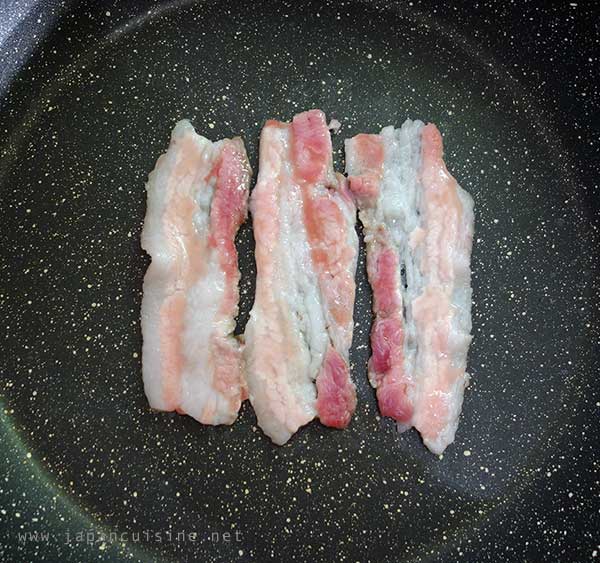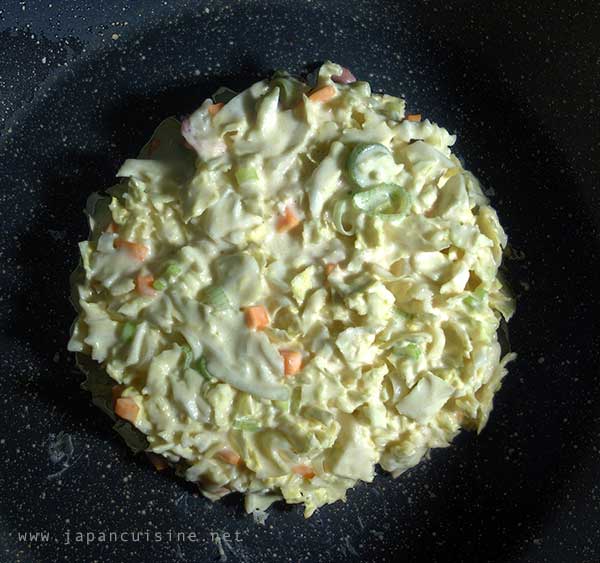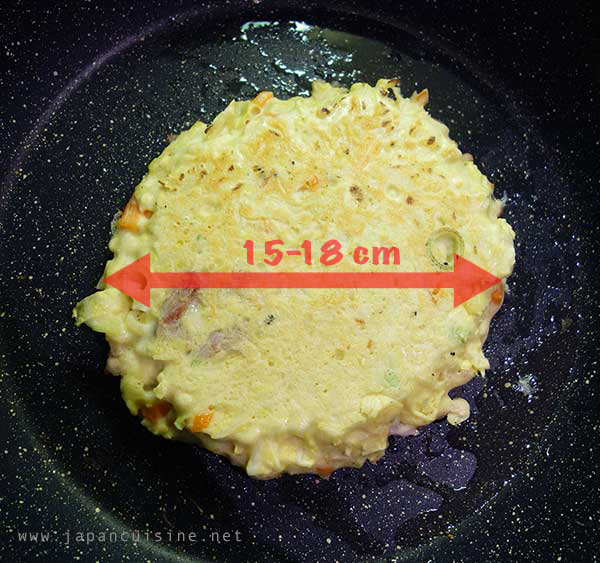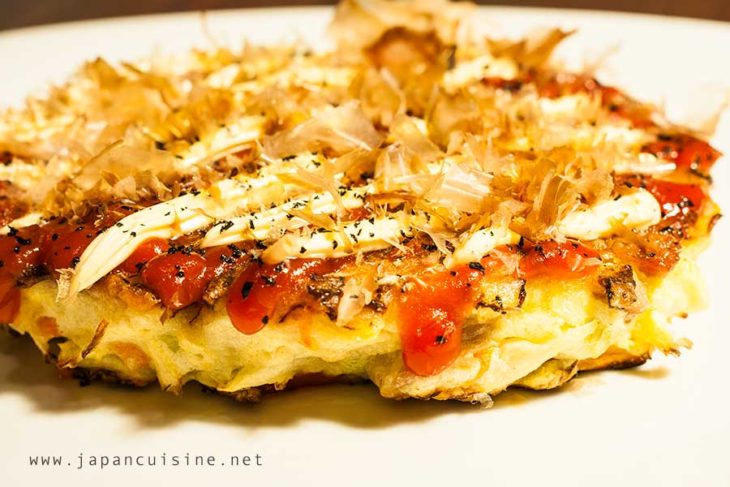
Okonomiyaki・お好み焼き – Cabbage Pancake
Okonomiyaki belongs in Osaka like pizza belongs in Naples. It is the dish that most represents the soul of the city, the true gastronomic capital of Japan: genuine, straightforward, rich in taste and flavour.
By describing its ingredients: cabbage, bacon, mayonnaise, katsuobushi (flakes of dried tuna), many could turn up their nose, especially the snobs who, without knowing the real Japanese cuisine, think it is always and exclusively “minimalist”, “refined”, “deconstructed”. And yet okonomiyaki, which literally means “cooked as you like”, delights everyone. It is the dish that friends and relatives request me the most. “Oh, when are you doing again that Japanese thing with the cabbage?” I ofted get asked.
Born as poor street food that put together a bunch of cheap ingredients, it is now very popular throughout Japan. Its preparation has now stabilised over the years, even if, just like pizza, there are infinite variations, even very elaborate ones, like the version of Hiroshima with spaghetti on top. As the name says, you can put in it pretty much aything you want.
In Osaka, okonomiyaki restaurants are numerous, ranging from big chains like Fugetsu to small family run restaurants, often with take-away formula (mochikaeri).
I’m presenting here the basic recipe. Just like pizza, okonomiyaki has its own basic version where you can add dtuff to make it richer. For example, the first level up requires a handful of squid cut into squares.
Okonomiyaki Ingredients
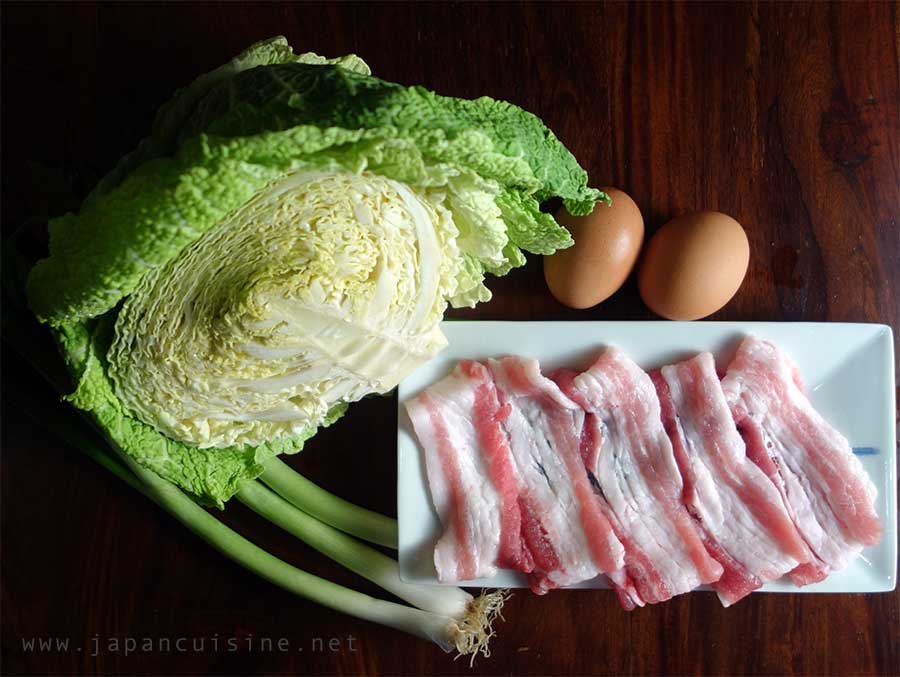
For 2 okonomiyaki (usually, just like pizza eats one each):
- 300g (10 oz) cabbage (the original recipe is for cabbage. If the one you find haas too thick leaves okonomiyaki may result watery. In this case is better to use cabbage that has thinner and drier leaves).
- 2 eggs.
- 30g (1 oz) chives (negi).
- 6 slices of thinly sliced fresh bacon (if the one you find in the supermarket is too thick, have the butcher machine cut it. The ideal is 3-4 mm thick). N.B.: for okonomiyaki you use FRESH bacon, NOT the smoked and seasoned one!
- 150g (5 oz) of flour 00.
- 100ml (3,5 fl oz) of dashi (dashi is the basic broth of Japanese cuisine. It is used to enhance that typical savoury taste that the Japanese call umami). You can also use instant one. Alternatively, use a normal granular fish broth or, in the worst case scenario, slightly salty water.
- A spoonful of diced beni-shoga. This is ginger in red shiso brine. It is very common in Japan and is already sold diced 2-3mm thick. Alternatively you can use fresh ginger and add diced carrots to add some color.
- 50g (1.7 oz) of grated nagaimo. In the West it is not always easy to find. In the description of the preparation I will explain how to do without.
- Variants: to the basic version of the mixture you can add cuttlefish cut into small squares, or shrimps, chopped octopus, cheese, etc.. The limit, as for pizza, is only imagination.
For the topping:
- Mayonnaise
- Okonomiyaki sauce. In recent years it is quite available, both in Asian shops and online. Alternatively you can use a DIY version by stirring 1 teaspoon of soy sauce for each spoon of ketchup.
- Aonori: in the West you can sometimes find it in oriental products shops or online.
- Katsuo-bushi: dry and smoked tuna shavings, one of the most important ingredients in Japanese cuisine.
Preparation
Wash and dry the cabbage, remove the tough center vein and chop it coarsely.
Pro tip: after cutting the cabbage, put it in the fridge for a couple of hours to dry. The okonomiyaki will be softer without being watery.
Cut the chives or the spring onions into thin slices.
Dice the beni-shoga into 2-3mm pieces. Beni-shoga is ginger in red shiso brine. It takes on a bright purple-red color. In Japan in supermarkets you find it already chopped into ready-to-use bags. The one I use is home made by a lady from Wakayama, and every year she gives me a good amount of it in exchange for a pack of chocolates of a well-known brand that she likes a lot. It is not essential but it gives okonomiyaki a special accent. You can also use fresh ginger. In this case you can add some diced carrots to add some color.
If the bacon slices are too thick pound them out with a meat tenderizer.
Beat the eggs with flour and dashi. You must obtain a mixture that is not too thick but not too watery and without lumps, similar to the pancakes dough.
Dashi or granular stock is not essential but it makes okonomiyaki tastier.
Pro tip: add freshly grated or powdered nagaimo (Dioscorea japonica) to make the mixture stickier and give okonomiyaki softness. In many western countries, however, it is not easily found. You can whip the egg white until they are stiff and then add it to the yolk previously beaten with flour and dashi. The consistency must be that of cream.
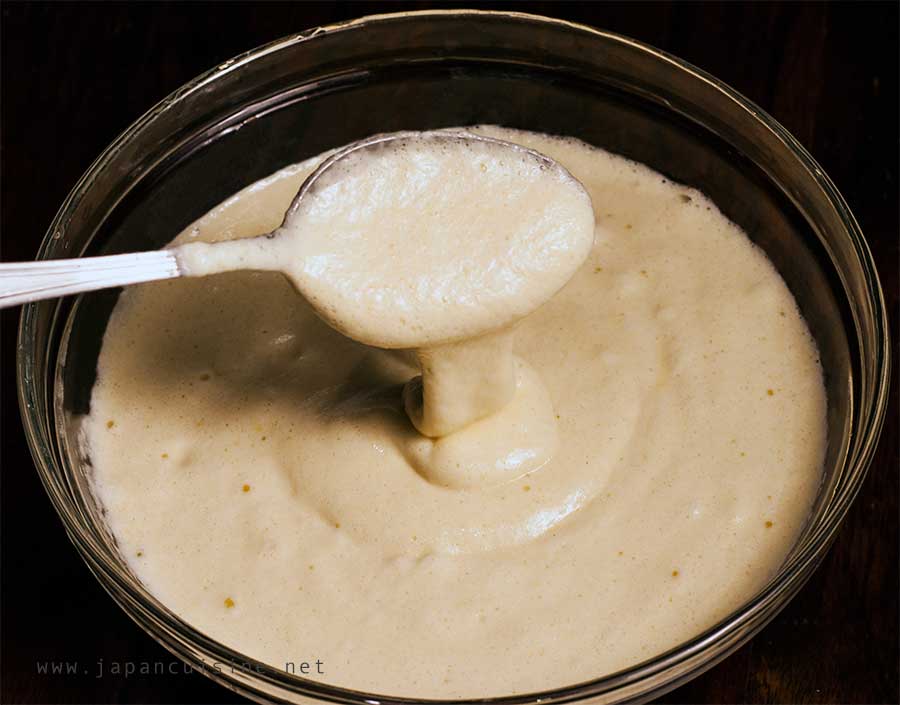
In a bowl, mix the chopped cabbage with chives, ginger and egg batter. The cabbage must be mixed evenly with the egg.
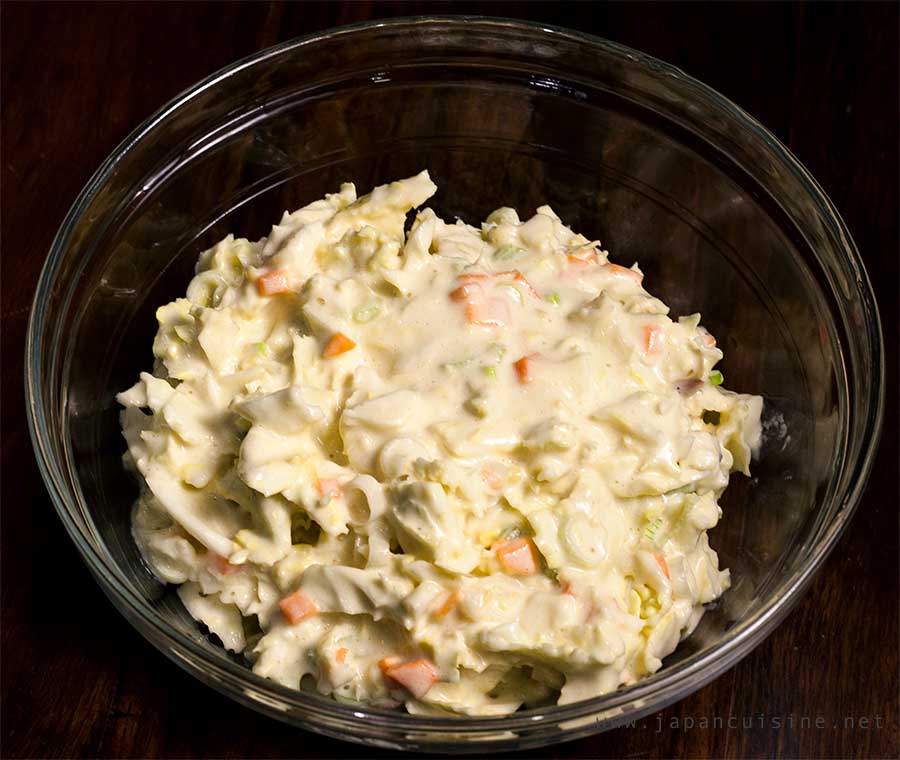
Let’s move on to cooking.
Cooking
In the Japanese okonomiyaki restaurants there is a hot metal plate (teppan 鉄板) in the middle of the tables around which customers seat. The waiters cooks okonomiyaki there in front of you. In Osaka, where everybody is an okonomiyaki expert, there is the DIY option. The waiter brings the ingredients and the customer cooks it directly on the table.
For home preparation, you can use a non-stick crepe pan instead, which does its job beautifully. Even a normal pan will do.
- Heat it well with a drizzle of oil.
- Put 2 or 3 slices of bacon well spread out. Let it warm so that the fat melts and greases the plate well.
- Pour the mixture of cabbage and beaten egg on the bacon, forming a sort of circular omelette about 15-20 cm (6-7″) in diameter and 2-3 cm (3/4 – 1″) thick. Use a spatula to give the cabbage a regular and compact shape.
- Leave to cook over medium heat until the egg, solidifying, makes the okonomiyaki compact enough to turn it.
For the operation I use a special tool that you see in the picture and that I purchased at doguya-suji (道具屋筋) in Osaka, a entire street dedicated to professional catering equipment stores. A truly fascinating place. In fact, even a very large common spatula will do the job. Be careful not to break the okonomiyaki when you turn it over. It can be fixed but it is better to keep it as tight as possible. With a little practice you can easily do it.
- From now on you don’t have to press on it anymore to make it too compact. The grumpy old okonomiyaki cooks would get angry.
- Turn it a couple more times so that both surfaces have a uniform golded color but not charred. It’s important that the egg hardens and the cabbage is well cooked to get a good result. You can try internal cooking with a toothpick like you do with cakes. Stick it into the okonomiyaki and if you pull it out clean, it’s ready.
- At this point you move on to the topping.
Topping
- Put the okonomiyaki on a platter. Lay a veil of mayonnaise. The mayonnaise you can find is generally slightly more acidic than sweet Japanese mayonnaise, but it’s more than fine. Look for one with a delicate taste.
- Now pour, in a spiral or zigzag, a good dose of okonomiyaki sauce (お好み焼きソース). You should be able to find it in some well-stocked oriental products shops in big cities. My favorite is Otafuku (おたふく), but also Ikari (いかり), Fugetsu (風月), etc. are very popular. They are similar but each one has its own special taste, the result of recipes kept secret and in Japan everyone has their favorite.
An acceptable alternative is to mix ketchup with soy sauce. - Sprinkle some aonori on top (青海苔). Anori is nori powder. If you can’t find it, you can take nori in sheets (black sushi seaweed, for example) and powder it in a blender. It’s not exactly the same thing but it’s getting close.
- And finally a nice handful of katsuo. This is really essential and you’ll have to make sure you get it.
Pairings
Okonomiyaki is considered a one-course meal. At most, it can be accompanied by a few appetizers.
99% of Japanese people with okonomiyaki drink a good cold beer.
If you want to combine wine, you have to take into account the characteristics of the dish. Okonomiyaki has a great complexity and contrast of balanced flavors. Bacon and mayonnaise gives fatness. There is the sweet and sour aromatic sauce and katsuo with its smoky hints. The taste of okonomiyaki is on the whole strong but not overly intense. You will therefore need a non-aromatic wine, which does not create further contrast, with a certain acidity that cleans the palate between one bite and another. A nice dry sparkling wines would do the job, or a fresh white or rose wine, or a light red with good acidity.
Okonomiyaki should be served hot, so come on, let’s not waste any more time. Enjoy your meal!
